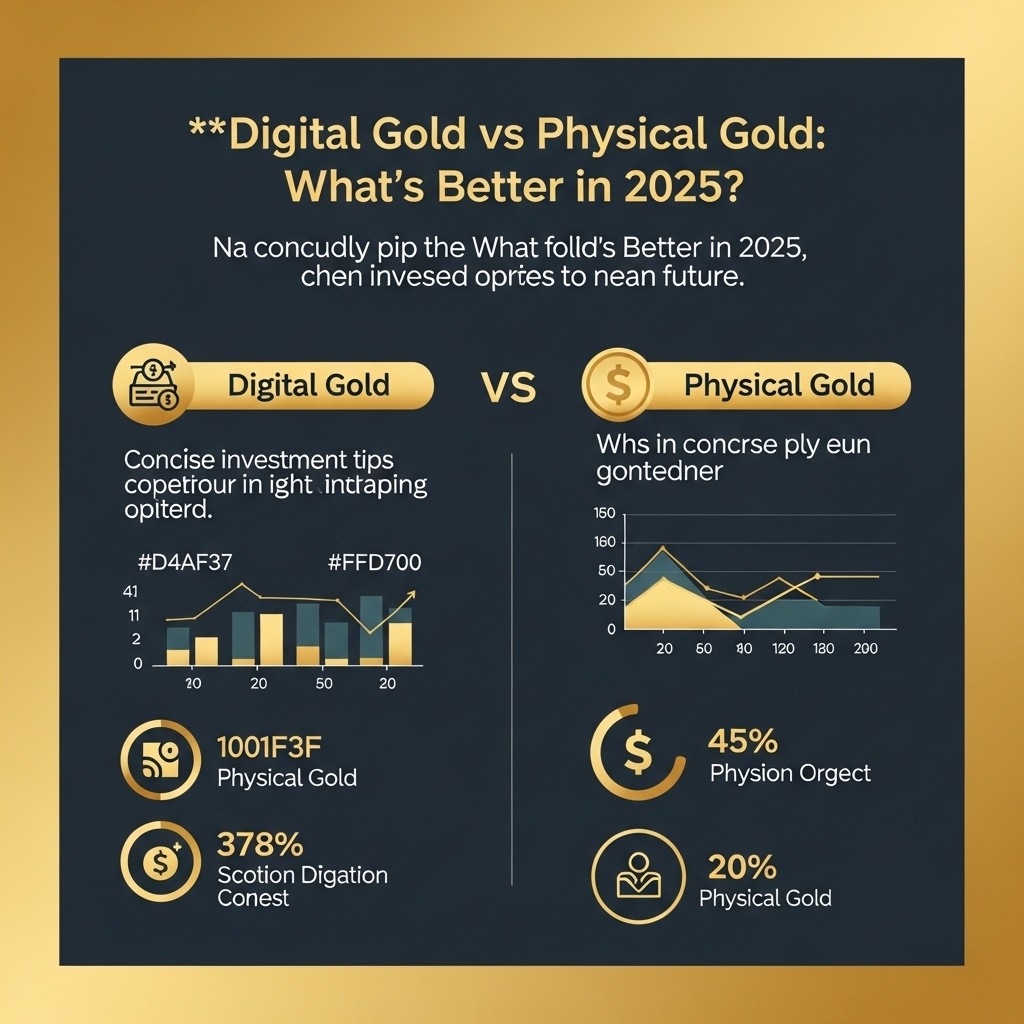Digital Gold vs Physical Gold: What’s Better in 2025?
The timeless allure of gold continues to captivate investors, especially as global economic landscapes shift with unprecedented speed. With inflation concerns persisting and geopolitical tensions simmering, gold’s role as a traditional safe-haven asset remains as strong as ever, offering a vital hedge against volatility and a reliable store of value. But in an era where digital innovation is transforming every facet of our lives, the very nature of gold ownership is evolving. This raises a pivotal question for every forward-thinking investor: As we approach 2025, which offers the superior financial advantage – the tangible security of physical gold or the modern convenience of digital gold?
This comprehensive guide is designed to equip you with the insights needed to navigate this crucial investment decision. We’ll delve into the distinct characteristics, financial benefits, and inherent risks associated with both traditional physical gold holdings and the burgeoning array of digital gold options, including gold-backed ETFs, digital tokens, and more. Our analysis will consider key factors such as liquidity, storage costs, transaction efficiencies, security protocols, and accessibility, all evaluated through the lens of anticipated market trends and technological advancements poised to shape 2025. By understanding the unique strengths and weaknesses of each, you’ll be empowered to make an informed choice that not only aligns with your investment goals but also maximizes your portfolio’s potential to leverage gold’s enduring value in the year ahead.
Gold Market Analysis and Key Insights
The gold market heading into 2025 continues to demonstrate its historical resilience as a safe-haven asset, significantly influenced by macroeconomic shifts and geopolitical uncertainties. Recent data shows gold prices nearing or surpassing all-time highs, driven by persistent inflation concerns, robust central bank purchasing, and a weaker U.S. dollar outlook. Investment demand remains strong, with both institutional and retail investors seeking shelter from market volatility.
Key Market Insights
Geopolitical & Inflationary Hedge
Global geopolitical tensions and ongoing inflationary pressures cement gold’s role as a vital hedge. Investors increasingly turn to gold to preserve purchasing power amidst currency debasement and economic instability, reinforcing its appeal as a crisis commodity.
Interest Rate Environment
The trajectory of interest rates will be crucial. While higher rates can increase the opportunity cost of holding non-yielding gold, a shift towards rate cuts or a sustained low-rate environment could provide significant tailwinds, reducing the appeal of competing fixed-income assets.
Digitalization of Assets
The burgeoning digital gold sector, leveraging blockchain technology, represents a growing trend. Platforms offering tokenized gold provide enhanced liquidity, fractional ownership, and lower entry barriers, attracting a new demographic of tech-savvy investors.
Investment Benefits and Considerations:
Physical gold offers tangible ownership, a traditional store of value, and protection against systemic failures. However, it incurs storage, insurance, and assay costs. Digital gold boasts superior liquidity, lower transaction fees, and ease of transfer, but introduces counterparty risk and regulatory uncertainty. Both offer portfolio diversification and an inflation hedge, but the choice hinges on an investor’s risk appetite, desired accessibility, and long-term objectives.
Expert Recommendations:
Financial experts generally advise a diversified approach. For those prioritizing tangibility and long-term wealth preservation, physical gold remains a cornerstone. However, for investors seeking greater liquidity, lower entry points, and seamless trading, digital gold presents a compelling alternative. A prudent strategy might involve allocating a portion to both, balancing traditional security with modern efficiency, while conducting thorough due diligence on all platforms and dealers.

Gold Investment Strategies and Options
When considering gold as an investment in 2025, a variety of strategies and options cater to different investor profiles and risk appetites. Understanding these is crucial for effective portfolio allocation.
Gold Investment Options:
* Physical Gold: This includes gold bars and coins. It offers tangible ownership but incurs storage, insurance, and potential assaying costs. Purity and authenticity are key considerations.
* Gold ETFs (Exchange-Traded Funds): These are popular for their liquidity and ease of trading. ETFs track the price of gold, often held by a custodian. They represent ownership of unallocated gold and do not involve physical possession.
* Gold Mining Stocks: Investing in companies that mine gold can offer leveraged exposure to gold prices. However, these stocks are subject to company-specific risks, operational challenges, and management quality.
* Gold Futures and Options: These derivative contracts allow speculation on future gold prices. They are highly leveraged and suitable only for experienced investors due to their complexity and high risk.
* Digital Gold: This increasingly popular option allows investors to buy fractions of gold digitally, often through apps. It offers convenience and lower entry barriers but raises questions about underlying asset security, custody, and regulatory oversight.
Risk Assessment and Portfolio Allocation:
Gold is often viewed as a safe-haven asset, capable of hedging against inflation and market volatility. However, its price can fluctuate significantly. A common strategy is to allocate a portion of a diversified portfolio to gold, typically 5-10%, to mitigate systemic risk. The choice between digital and physical gold, or other derivatives, will influence the specific risks undertaken, such as counterparty risk for digital gold or volatility for mining stocks.
Comparison of Investment Methods:
Physical gold offers direct ownership but is less liquid and incurs holding costs. ETFs provide liquidity and ease of access, mirroring gold’s price movements with minimal hassle. Mining stocks offer potential for higher returns but with added company-specific risk. Digital gold offers unparalleled convenience and fractional ownership, but due diligence on the platform’s security and regulatory compliance is paramount.
Market Timing Considerations:
While it’s challenging to time the market perfectly, investors often increase gold holdings during periods of economic uncertainty, rising inflation, or geopolitical instability. Conversely, in stable economic environments, gold’s appeal might diminish relative to growth-oriented assets. For 2025, monitoring inflation trends, central bank policies, and global economic sentiment will be key to informing your gold investment strategy.
Market Performance and Outlook
Gold has historically served as a resilient store of value and an effective hedge against inflation and economic uncertainty. Its performance over the past two decades demonstrates this, with significant price appreciation during periods of geopolitical instability (e.g., 2008 financial crisis, post-pandemic inflation surge). While 2022 saw some consolidation amidst aggressive interest rate hikes, gold rebounded strongly in 2023 and into 2024, frequently testing and breaking new all-time highs, underscoring its enduring appeal as a safe-haven asset.
As of late 2024, the gold market remains influenced by several critical factors. Persistent inflation concerns, albeit moderating in some economies, alongside ongoing geopolitical tensions globally, continue to underpin strong demand. Central bank gold purchases have also reached unprecedented levels, signifying a strategic move away from dollar-centric reserves. Looking into 2025, the outlook for gold appears positive. Anticipated interest rate cuts by major central banks, driven by easing inflation and potential economic slowdowns, are expected to reduce the opportunity cost of holding non-yielding assets like gold, further boosting its attractiveness. Economic volatility and currency fluctuations will likely maintain its safe-haven premium.
Key economic factors influencing gold prices include interest rates (typically inverse relationship), the strength of the US dollar (inverse relationship), inflation expectations (direct relationship), and global risk sentiment. Lingering concerns over sovereign debt, potential recessions, and an unpredictable geopolitical landscape position gold as a crucial portfolio diversifier, suggesting continued robust performance through 2025.
Frequently Asked Questions About Gold Investment
What is the primary difference between Digital Gold and Physical Gold?
Digital Gold represents a certificate of ownership over physical gold stored in a secure vault, typically purchased online in small denominations. Physical Gold refers to tangible assets like coins, bars, or jewelry that you hold directly.
Which offers better security and peace of mind in 2025?
Physical gold offers direct ownership but carries risks like theft and personal storage concerns. Digital Gold, while eliminating physical risk, relies on the security and reputation of the platform and custodian. Both have trade-offs; due diligence on the digital provider is crucial.
Is it easier to buy and sell Digital Gold or Physical Gold?
Digital Gold is generally easier to buy and sell online 24/7, offering high liquidity and fractional ownership. Physical Gold involves more steps for purchase, secure storage, and sale through jewelers or dealers, which can be less convenient.
What are the cost implications for storage and maintenance?
Physical gold often incurs explicit storage costs (e.g., safe deposit boxes, insured vaults) and potential insurance premiums. Digital Gold typically includes these costs within its price or via a small annual maintenance fee, making it often more cost-effective for smaller investments.
How do tax implications differ for Digital Gold vs Physical Gold?
Taxation varies by jurisdiction. Generally, both are subject to capital gains tax upon sale if a profit is made. However, specific rules for Digital Gold (e.g., treatment as an unlisted security or commodity) might differ from physical gold, so consulting a tax advisor for your location is recommended.
Which is more suitable for long-term investment?
Both can be suitable for long-term investment. Physical gold is often preferred by those who value tangible assets and direct control. Digital gold offers convenience, lower entry barriers, and easy diversification. The choice depends on individual risk tolerance, investment goals, and preference for tangibility versus accessibility.

Final Thoughts on Gold Investment
As we navigate towards 2025, the debate between digital and physical gold isn’t about one being definitively superior, but rather which aligns best with your investment strategy. Key takeaways highlight that physical gold offers tangible security and a hedge against systemic risk, though it comes with storage and liquidity considerations. Digital gold, conversely, provides unparalleled convenience, accessibility, and liquidity, making it ideal for smaller, more frequent transactions, but relies on digital platforms.
Our final recommendation isn’t a single choice, but a nuanced approach. For many, a diversified strategy blending both forms offers the best of both worlds: a foundation of physical gold for long-term security, complemented by digital gold for tactical flexibility and ease of entry. Ultimately, the better option is the one that fits your risk tolerance, investment horizon, and access needs. Evaluate your personal financial goals and assess how gold, in its most suitable form, can fortify your portfolio.